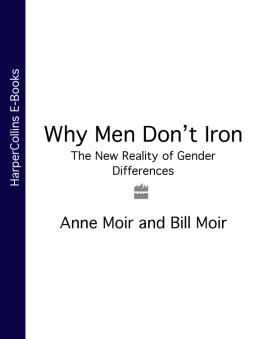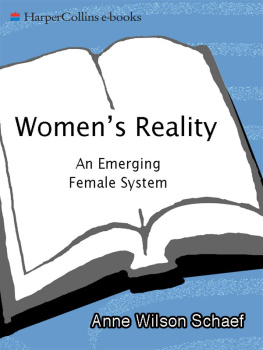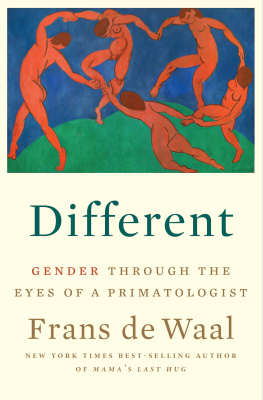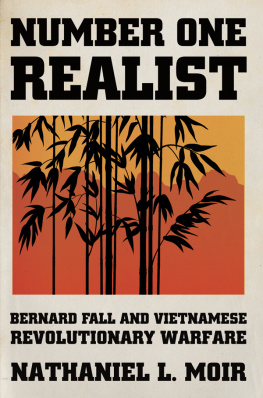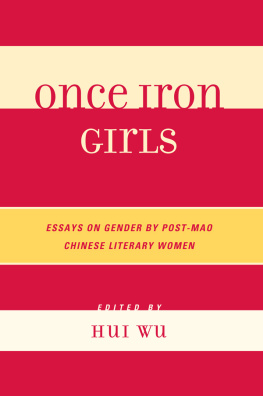Moir Anne - Why men dont iron: the new reality of gender differences
Here you can read online Moir Anne - Why men dont iron: the new reality of gender differences full text of the book (entire story) in english for free. Download pdf and epub, get meaning, cover and reviews about this ebook. City: London, year: 2015;2016, publisher: HarperCollinsPublishers, genre: Romance novel. Description of the work, (preface) as well as reviews are available. Best literature library LitArk.com created for fans of good reading and offers a wide selection of genres:
Romance novel
Science fiction
Adventure
Detective
Science
History
Home and family
Prose
Art
Politics
Computer
Non-fiction
Religion
Business
Children
Humor
Choose a favorite category and find really read worthwhile books. Enjoy immersion in the world of imagination, feel the emotions of the characters or learn something new for yourself, make an fascinating discovery.
- Book:Why men dont iron: the new reality of gender differences
- Author:
- Publisher:HarperCollinsPublishers
- Genre:
- Year:2015;2016
- City:London
- Rating:5 / 5
- Favourites:Add to favourites
- Your mark:
- 100
- 1
- 2
- 3
- 4
- 5
Why men dont iron: the new reality of gender differences: summary, description and annotation
We offer to read an annotation, description, summary or preface (depends on what the author of the book "Why men dont iron: the new reality of gender differences" wrote himself). If you haven't found the necessary information about the book — write in the comments, we will try to find it.
Moir Anne: author's other books
Who wrote Why men dont iron: the new reality of gender differences? Find out the surname, the name of the author of the book and a list of all author's works by series.
Why men dont iron: the new reality of gender differences — read online for free the complete book (whole text) full work
Below is the text of the book, divided by pages. System saving the place of the last page read, allows you to conveniently read the book "Why men dont iron: the new reality of gender differences" online for free, without having to search again every time where you left off. Put a bookmark, and you can go to the page where you finished reading at any time.
Font size:
Interval:
Bookmark:

Gender Differences

To Bernard Cornwell
This is a book about men.
About what makes them different. So inevitably it is a book about women too.
A small box sits on Annes desk. The top reads: All that men know about women. Open it and there is nothing inside. Funny? Sad? Humbling? An innocent admission that men have tried to follow womens pattern of thought and failed? Or is it an insult? The box could imply that a man is incapable of understanding a woman because her complexities are beyond his simplicities. That is to define him in her terms. Or perhaps it reflects the traditional male view that she is beyond understanding because she is silly irrational? Which is to define her in relation to himself. We tend to see in the other sex a lesser version of our own. Yet the manner in which we describe anothers mind shows the limits of our own.
Why keep the box? asks Bill.
To turn it over, says Anne. To puzzle out what it means.
Isnt it insulting?
Didnt you say that we often hide behind clichs?
Did I?
When you gave me the box.
It is a clich that men cannot fathom women. But what of her image of him?
Roseanne Barr, the weighty sitcom actress, summed up her view Such expertise was rewarded when Barr was appointed editorial adviser to a special issue of the New Yorker devoted to the subject of women.
Men are nothing but overgrown children, really.
They need to be told what to do.
The only difference between men and boys is the price of their toys.
Boys will be boys: they have to watch football.
Wars are little boys fighting.
In Alison MacLeods postmodern novel The Changeling, the big themes of boys history war, political intrigue and empires are represented as comic and trivial.
It is common for women to describe men as boys. To her way of thinking he never grows up, while she does. This attitude is as matronizing as his is patronizing. He puts her down by claiming not to understand her, that she is indeed beyond understanding, and she keeps her self-respect by claiming the opposite. Men and women are seldom more equal than in their lack of understanding of one another. Why else would women enjoin men to get in touch with their feminine side? But where does he find it? How does he look for it? Does it even exist? Perhaps, as Gertrude Stein said of Oakland, California, there is no there there. To ask men to improve themselves by relating to their feminine side is to ask them to become like women, but men are distinct: they are possessed of the differences that make for a real difference.
So why, some women ask, must his differences make him so brutally dominant? For too long, she feels, he has forced her into his social frame, into the role of the wife or the little woman, excluding her from his privileged world. As a result women feel anger and resentment, which are not unjustified. There is a need to strike a better balance between the traditional male view that he must manage her world (protect her; give her what he wants) and the hardline feminist view that she should gain power over his world (to protect both her and him from himself).
One way out of the conflict between his view of her and hers of him is to claim that there is essentially no difference between men and women. Anything he can do, she can do. Underpinning that conviction is the idea that, when we look beyond the obvious physical attributes, mens and womens brains are the same. But they are not. Science has upset the egalitarian applecart by conclusively showing that the sexes are distinct in how they act and think.
Some people will argue against the science, while others will accept that while there are differences between the sexes, those differences are socially engendered (they even claim that the brain differences are socially engendered) and what society can construct, society can also destroy. In other words, by a conscious act of will, we can create the egalitarian ideal. This is the message of most university-based Gender Studies.
Gender refers to sex differences, both social and biological, but most who teach gender studies today choose to define gender to mean only those differences that are the results of cultural pressures. Gender is constructed and social, (neither more nor less) says a contributor to Feminist Approaches to Science. It is the politics of the socialisation of sex.course on sex differences that excludes the real study of sex differences which must include biology.
It is insulting to the reader to qualify everything to death. This is a book about the biological science of gender differences, and science is about the probable. There is no need to keep saying this. So when we write Science finds such and such it plainly means that this is the best bet: no more, no less. Similarly, a word like men is used as a general term for most men men in general. In the use of such a general term there will plainly be exceptions. Thus, when we write: Men run 8% faster than women, we leave it to the fourth-rate mind to point out that some women run faster then most men.
Our aim is to explain, not to campaign.
Todays man is under pressure to change. He is told to get in touch with his feelings, to be more considerate, to be more communicative and open to his emotions. Yet this new, softer, more caring male, just like the old-fashioned patriarchal man, is a one-dimensional caricature of what it is to be masculine. It is a form of sexism, a masculine stereotype as extreme and as crudely reductionist as its predecessor, the traditional male.
The traditional male is a dominating bully, a misogynist who stamps his views on women. He believes the female is merely a pale and inferior copy of himself, an adumbration of the superior male. This male sets the standard: he is normal, she is deficient. He sees only one side, his.
Any man who matches this stereotype is indefensible, for he reduces women to an inferior status by denying her essential and valuable feminine qualities. But equally, those with a gender agenda deny the essential male qualities.
The new, caring male has recognized his shortcomings and corrected them. He sees that the old sex boundaries had nothing to do with biology, but were the results of social pressures (perhaps he was given toy guns instead of dolls). This is the male who has got in touch with his female side, and the defining quality of his masculinity has become the denial of his masculinity. She is the new standard, and he can only aspire to be more like her.
The reader may find one or both of these views a farrago of nonsense. But both viewpoints, if only because they are widespread, must be taken seriously. Each highlights a set of social aspirations and both lead to false expectations. Past and present views of the male traditional and postmodern are equally poor measures of the masculine.
The traditional male is well known; the postmodern version is less so (at least outside the academic world). The new man is predicated on the understanding that all significant differences in gender are socially conditioned, constructed or learned. This is crucial. A man is not born a man, but is made into one by the assumptions of the culture in which he grows up. Take away the assumptions and he would grow up what? A woman? There is an ambivalence here, but we need to recognize that there is a ritual obeisance in postmodern studies to all things complex and ambivalent. Postmodernism is a rejection of hitherto accepted certainties. Uncertainties are therefore good. The ambiguous is good, the clear-cut is bad. Seeing things as good or bad is also bad; right or wrong is wrong, and clarity is out.
Font size:
Interval:
Bookmark:
Similar books «Why men dont iron: the new reality of gender differences»
Look at similar books to Why men dont iron: the new reality of gender differences. We have selected literature similar in name and meaning in the hope of providing readers with more options to find new, interesting, not yet read works.
Discussion, reviews of the book Why men dont iron: the new reality of gender differences and just readers' own opinions. Leave your comments, write what you think about the work, its meaning or the main characters. Specify what exactly you liked and what you didn't like, and why you think so.

